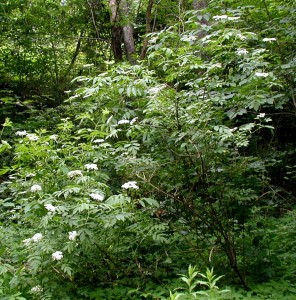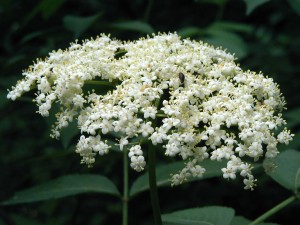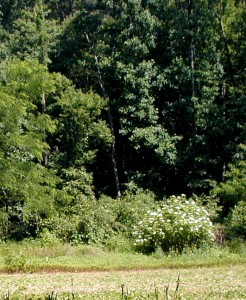Elderflowers bloom at the end of spring and the beginning of summer and ripen into dark purple elderberries by the end of summer.

In the photo above taken 6 June 2010 there are over 3 dozen elderflower clusters. Additional flower clusters were observed blooming on the same plant on 22 June 2010. The flower clusters occur at tips of branches. When the elderberries ripen they get heavy enough to bend the branches down. Berries are ripe for picking when the clusters hang down and are very dark purple.
Elderberry shrubs, Sambucus canadensis, have large, opposite, pinnately compound leaves with leaflets opposite one another. Toothed leaflets are lance-shaped and occur in pairs except for the terminal leaflet.

Note that the upper right leaf has nine toothed leaflets. The flower cluster rises up from the terminal end of the branch between two compound leaves.
Individual elderflowers are creamy white with five rounded petals and protruding stamens, which gives the flower cluster a fuzzy appearance from a distance.

All around the area we see elderflower bushes at the edge of fields, where the trees meet the open sunny fields. Many bushes are growing near water, in culverts, in drainage areas, and near streams. The tall elder shrub photographed above grows next to the edge of a lane where a natural spring trickles water down the side of the road, especially in Springtime and after heavy rains.

When the elderberry bushes are in bloom is the best time to find these shrubs if you’re going to collect the elderberries. The berries won’t ripen until late summer. By then we’ll be ready to make elderberry jelly!

I have a photo of a plant that is growing in our backyard by our fence.
That’s nice, Kelly Ann. But what is interesting about the plant by the fence? Why did you photo it?